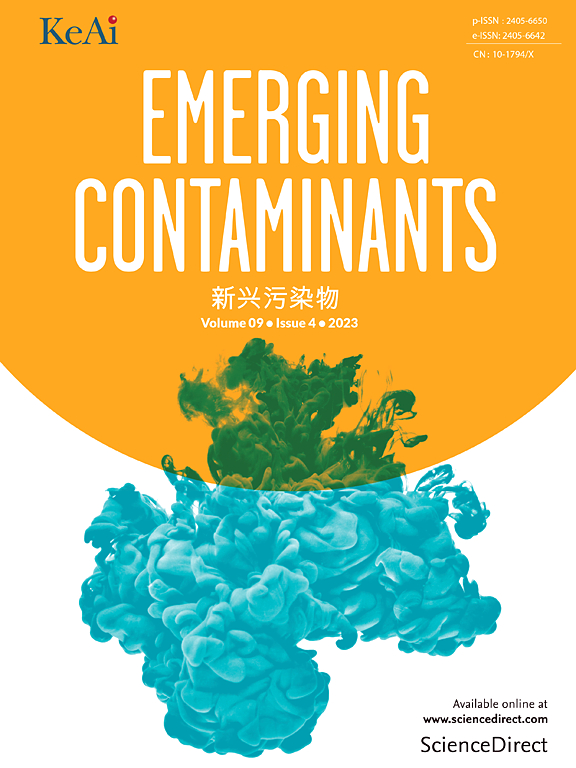Pharmaceuticals and personal care products in soil: Sources, impacts and myco-remediation strategies
IF 6.9
2区 环境科学与生态学
Q1 ENVIRONMENTAL SCIENCES
引用次数: 0
Abstract
Bioremediation is an effective and sustainable method for removing xenobiotic pollutants from the environment, utilizing microorganisms and plants to metabolize harmful chemicals into harmless compounds like CO2 and water. Among various bioremediation strategies, mycoremediation stands out due to the unique enzymatic capabilities and metabolic diversity of fungi, enabling them to degrade persistent and toxic pollutants under harsh environmental conditions. This review specifically addresses the application of mycoremediation to emerging contaminants pharmaceuticals and personal care products (PPCPs) which pose significant environmental challenges due to their persistence, bioaccumulation potential, and ecotoxicity.
This article provides a comprehensive overview of fungal-based strategies for PPCP remediation, documenting the fate, distribution, and impacts of these contaminants in soil. It highlights the enzymatic mechanisms and fungal species involved in PPCP degradation, with an emphasis on their ecological resilience and pollutant-specific adaptability. Additionally, the review explores under-discussed factors influencing fungal efficacy, such as pH, temperature, and contaminant concentration, alongside innovative advancements like myco-nanotechnology and enzyme engineering that enhance remediation efficiency.
By integrating these aspects with policy perspectives and sustainable development goals, this review contributes novel insights into the potential of mycoremediation as a cutting-edge approach for mitigating PPCP contamination. It underscores the role of fungi in advancing circular economy principles and offers a foundation for future research and practical applications in environmental management.
土壤中的药物和个人护理产品:来源、影响和真菌修复策略
生物修复是一种从环境中去除外源污染物的有效和可持续的方法,利用微生物和植物将有害化学物质代谢成二氧化碳和水等无害化合物。在各种生物修复策略中,真菌修复因其独特的酶促能力和代谢多样性而脱颖而出,使其能够在恶劣的环境条件下降解持久性和有毒污染物。本综述特别讨论了微生物修复在新兴污染物药品和个人护理产品(PPCPs)中的应用,这些污染物由于其持久性、生物蓄积潜力和生态毒性而对环境构成重大挑战。本文提供了基于真菌的PPCP修复策略的全面概述,记录了这些污染物在土壤中的命运,分布和影响。它强调了参与PPCP降解的酶机制和真菌物种,重点是它们的生态弹性和污染物特异性适应性。此外,本文还探讨了影响真菌功效的未被讨论的因素,如pH值、温度和污染物浓度,以及诸如真菌纳米技术和酶工程等提高修复效率的创新进展。通过将这些方面与政策观点和可持续发展目标相结合,本综述为分枝修复作为减轻PPCP污染的前沿方法的潜力提供了新的见解。它强调了真菌在推进循环经济原则方面的作用,并为未来在环境管理方面的研究和实际应用奠定了基础。
本文章由计算机程序翻译,如有差异,请以英文原文为准。
求助全文
约1分钟内获得全文
求助全文
来源期刊

Emerging Contaminants
Medicine-Public Health, Environmental and Occupational Health
CiteScore
10.00
自引率
6.70%
发文量
35
审稿时长
44 days
期刊介绍:
Emerging Contaminants is an outlet for world-leading research addressing problems associated with environmental contamination caused by emerging contaminants and their solutions. Emerging contaminants are defined as chemicals that are not currently (or have been only recently) regulated and about which there exist concerns regarding their impact on human or ecological health. Examples of emerging contaminants include disinfection by-products, pharmaceutical and personal care products, persistent organic chemicals, and mercury etc. as well as their degradation products. We encourage papers addressing science that facilitates greater understanding of the nature, extent, and impacts of the presence of emerging contaminants in the environment; technology that exploits original principles to reduce and control their environmental presence; as well as the development, implementation and efficacy of national and international policies to protect human health and the environment from emerging contaminants.
 求助内容:
求助内容: 应助结果提醒方式:
应助结果提醒方式:


